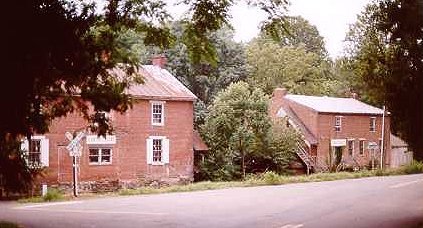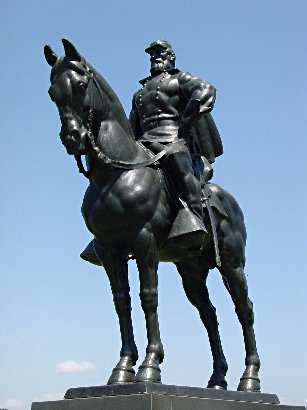
First Manassas
July 21, 1861
After the firing on Fort Sumter in April 1861, the Union and Confederate governments quickly recruited armies. Confederates under Brigadier Generals P.G.T. Beauregard and Joseph E. Johnston assembled at Manassas, Virginia and the Shenandoah Valley to defend against a Federal invasion. In July, the Union armies began the invasion that they hoped would end the war.

Piedmont Station
In the Shenandoah Valley troops under Gen. Patterson slowly advanced on Johnston while, Gen. McDowell 's 35,000 men advanced from Washington toward Manassas. Patterson's slow advance allowed Johnston to reinforce Beauregard by rail. Here at Piedmont Station, now Delaplane, Johnston's men boarded trains for Manassas. Johnston's 11,000 men brought Confederate strength at Manassas up to 33,000 men. Johnston outranked Beauregard but gave him control of the battle since he was more familiar with the terrain.

Matthews Hill
On the morning of July 21st, the two armies faced each other along Bull Run creek. Beauregard attempted to attack across Bull Run and turn the Union left flank, but various mix ups sabotaged the plan. McDowell had a similar plan and sent most of his army across Bull Run at Sudley Springs Ford to the north to move on the Confederate left flank. Approaching along the Sudley Road, visible on the right half of the picture, the Federals were forced to deploy near here and attack Col. Evans, who had detected the Union move and put his Confederate brigade on Matthews Hill to delay the Federals. Evans' brigade was reinforced by Bee's and Bartow's brigades, but they were forced back to Henry House Hill in confusion. In these early naive times, an easy Union war winning victory appeared in the offing.

Statue of "Stonewall" Jackson"
Rallying his men, Bee pointed to Thomas J. Jackson and his recently arrived brigade from the Shenandoah and said, "There stands Jackson like a stone wall. Rally behind the Virginians." From then on, Jackson and his brigade would forever be called "Stonewall". Beauregard and Johnston also helped rally the men and bring up reinforcements, forming a line behind the crest of the hill.

From Henry House Hill
This is the view looking from near the Henry House, visible on the left of the picture. On the right of the picture at the foot of the hill is the Stone House, which would be used as a hospital during the battle. The hill behind the Stone House is Buck Hill, beyond which is Matthews Hill, where Evans, Bee, and Bartow had held off the advancing Yankees in the morning. With increasing pressure, the Confederates had fallen back in confusion to Henry House Hill, where they were rallied and reinforced into a line at the distant treeline behind the modern Jackson statue. Union artillery, however, bombarded more forward Confederate guns on Henry House Hill from positions on Buck's Hill and Dogan's Ridge. The Confederates guns fell back to in front of the infantry line, and Union fire, which followed the retreating rebels also hit the Henry House, which the 85 year old widow Judith Henry had returned to after vacating the house earlier in the day. The widow would not survive the battle.
At 2 P.M. the Federals resumed the advance. McDowell had infantry at the foot of the hill ready to advance, deployed along the Warrenton Turnpike, which is perpendicular to Sudley Road. He also wanted artillery as part of the advance. Major Barry, the Union artillery commander, ordered the batteries of Griffin and Ricketts to advance from Dogan's Ridge to Henry House Hill, promising them the support of the 14th Brooklyn, a famous pre-war Zouave unit. The infantry support lagged, and the two artillery batteries came onto the plateau just 330 yards from Imboden's line of Confederate guns - well ahead of the main infantry advance, and with their supports lagging. Griffin's smoothbores unlimbered to the left of Henry House, in an area off the picture to the left, while Ricketts' rifled guns took position in some low ground to the right of the house. The cannon shown here represent these guns.

Imboden's Guns
This is the view from Imboden's line of guns. The infantry of Evans, Bartow, and Bee had joined Jackson and Hampton with their brigades and had rallied at the treeline on the reverse slope. Later in the battle, this hilltop would see confused clashes of Union and Confederate infantry.
Back to Civil War Virtual Battlefield Tours